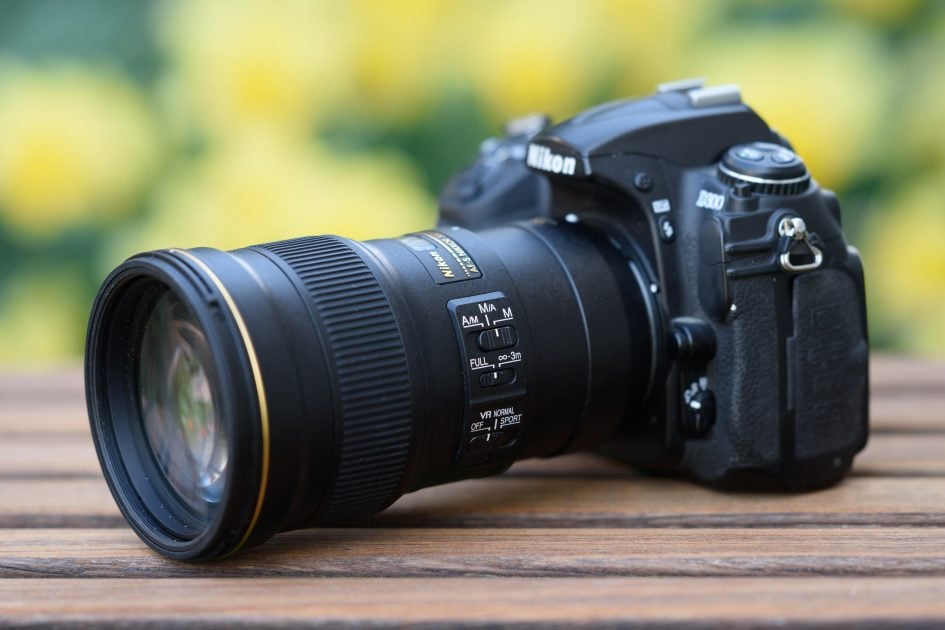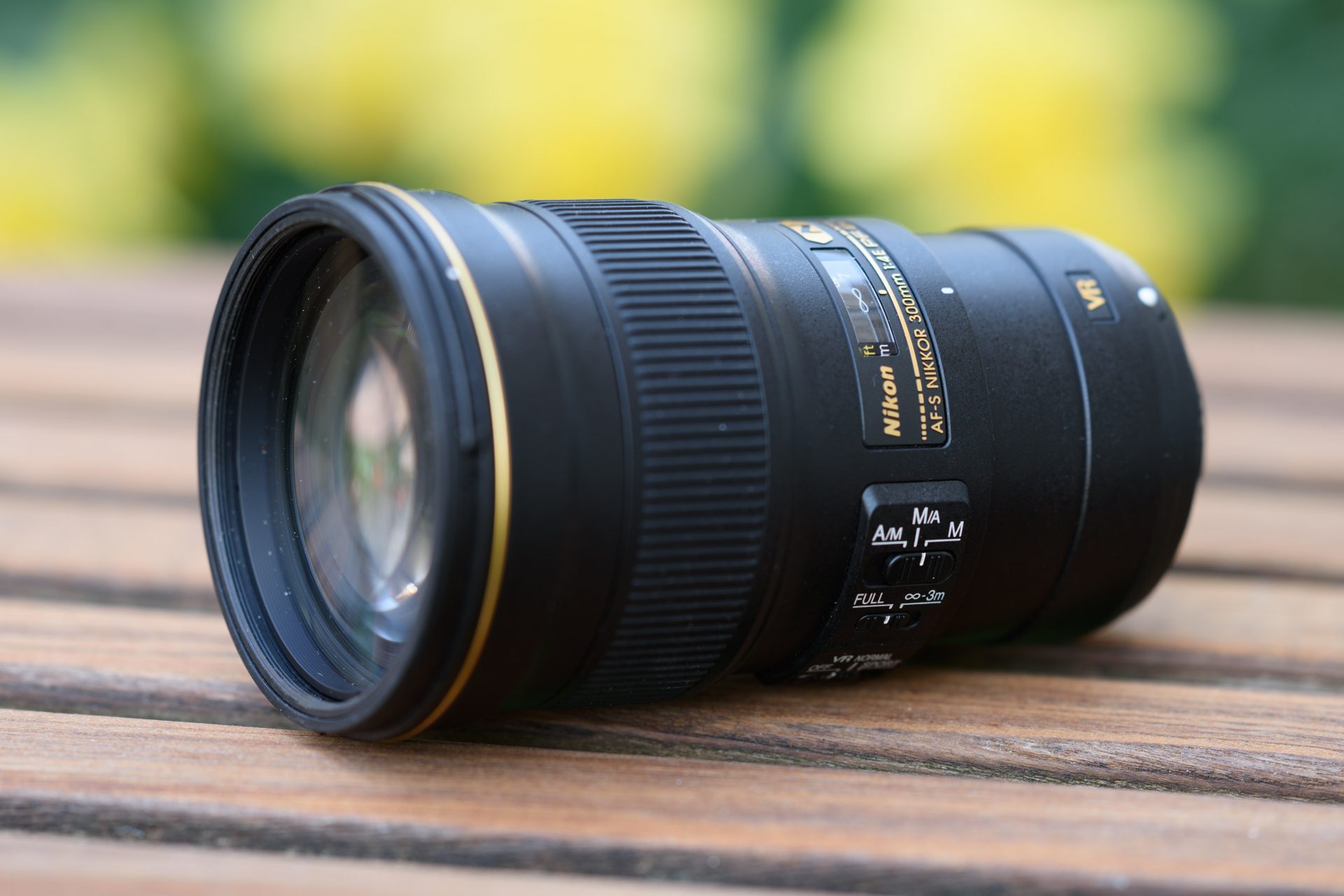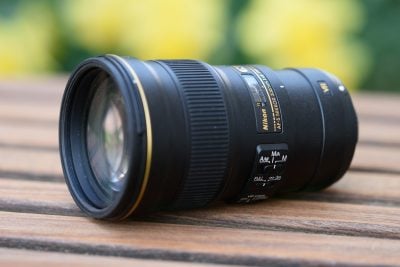Nikon 300mm f4E VR review
-
-
Written by Thomas
Intro
The AF-S Nikkor 300mm f/4.0E PF ED VR is Nikon’s long awaited successor to the venerable and now 14-year-old AF-S 300/4.0D. The new lens is much smaller and lighter than its predecessor – in fact even compared to any other full-frame 300/4.0 lens currently on the market. And it sports Nikon’s latest version of VR image stabilization. But it’s also considerably more expensive than the old 300/4.0D which had a reputation for very good image quality and a flimsy tripod-mount. So the big question is: are the improvements really worth the money?
A focal length of 300mm does not seem very long today: many zooms reach 300mm on the long end. But while 300mm is a little short for serious birders, it’s sufficient to capture action or larger animals from a fair distance. So a 300mm f4.0 lens is sort of a compromise: a good reach combined with a good separation of the subject from the background at f4 without being too narrow for your subject or too extreme in size and weight to make it impractical. In my Nikon 300mm f/4.0E PF ED VR review I’ll put this lens to the test on a 36MP Nikon D810 body to see whether it’s a good match for Nikon’s highest resolution full-frame DSLR, and I’ll also include many comparisons with the older 300/4.0D version.

Facts from the catalog
As usual I’ll have a look at the technical data first. I’ve rated the features with a [+] (or [++]), when it’s better than average or even state of the art, a [0] if it’s standard or just average, and [-] if there’s a disadvantage. I’ll compare it with Nikon’s AF-S 300/4.0D ED (the “300/4.0D” or “predecessor” for short).
Size (diam. x length): 89x148mm (3.5 x 5.8 in.). This – combined with the low weight – is one of the most distinguishing features of this lens. Its predecessor measures 90x223mm, which is deemed “normal” for a lens with 300mm focal length. The lens hood adds another 62mm and brings the new lens to a total length of 200mm while the old 300/4.0D is 273mm long with its lens hood extended. In practice the new lens is not much bigger than Nikon’s 24-70/2.8G standard-zoom. [+]
Weight: 755g (26.6 oz) vs. 1440g / 50.8 oz for its predecessor. This is an absolutely fantastic low weight for the new lens. It’s similar to the Nikon AF-S VR 70-300mm 4.5-5.6G IF-ED but that lens offers only f5.6 at 300mm focal length. If you look more closely into the numbers for absolutely comparable results you should add the weight of the lens hood to the 300/4.0E VR which brings it to 812 g and subtract the tripod-mount which brings the predecessor down to 1295 g. Still a reduction in weight of almost 40%. [+]
 |
Optics: 16 elements in 10 groups. This is pretty much for a fixed-focal. Its predecessor had only 10 elements in 6 groups. The lens features Nikon’s Nano Crystal Coat to reduce flare and ghosting. Plus it has one extra-low dispersion element and a so-called Phase Fresnel lens element (shown in green). This is the main reason for the lens’s compact size and low weight. But there is a caveat (quote from Nikon’s website): “[…] when there is a strong light source within the frame or when light enters the lens from outside of the frame, ring-shaped colored flare may occur according to shooting conditions”. Two other features stand out: The lens offers an electromagnetic aperture mechanism that should result in faster and more precise control of the aperture and the front lens has a Fluorine coating that “effectively repels dust, water, grease or dirt, ensuring easy cleaning”. So all-in-all a very advanced design. [+]
Minimum focus distance/max. magnification: 1.4 m (4.4 ft.) / 1:4.2. I my tests I got down to 1.31 m and 1:3.8 magnification with manual focus. The 300/4.0D reaches 1.45 m / 1:3.7 on paper and 1.39 m / 1:3.4 in my test. That’s a nice magnification that you can reach at a convenient distance, and at the top of the range for 300mm fixed-focals. The lens also offers a limiter switch that reduces the MFD to 3m to speed focusing up a bit. [+]
Filter size: 77mm = standard with most pro-lenses and identical to its predecessor. [+]
Image stabilization: Yes, VR 4th (?) generation. At a focal length of 300mm and with today’s high resolution sensors image stabilization is an indispensable feature. Its predecessor had no image stabilization at all. The VR can be switched off and also offers a “normal” and a “sport” mode. The latter is recommended when “photographing athletes and other subjects that are moving rapidly and unpredictably”. [+]
Autofocus: AF-S with SWM (silent wave motor), so it does work on D60/3×00/5×00-bodies. Manual-focus override is by simply turning the focus ring. [+]
Covers full frame/FX or smaller = very good. [+]
Price: around 2000 EUR new (incl. 19% VAT). The predecessor is currently available at around 1150 EUR – and that does include a tripod ring. [-]
Comes with a very nice semi-soft lens-case that is well padded, the lens-caps are standard Nikon’s, the plastic lens-shade is included and reversible for transport,. The front of the lens hood is flat so if you put the lens “face-down” on a flat surface it is not so prone to topple over. But the removable tripod-collar is not included! Would I miss it? Well no: at 800g the lens is not too heavy for the camera-body to bear the weight. So you can mount the camera-lens combo easily at the tripod-mount of the camera body – which has the added benefit that mirror-/shutter-slap is better damped. The tripod-collar of the 300/4.0D was notorious for it’s flimsy construction and resulting micro-blur even on the best and sturdiest tripods. [+]
Distance information is relayed to the camera, so the Nikon body can do all the advanced exposure-related stuff with this lens. [+]
Aperture ring = no. [0]
Sealing: yes! A rubber grommet at the lens-mount and a rubberized front-end that acts as a seal when the lens-cap is attached. The 300/4.0D does not offer that kind of protection. [+]
The score in the “features-department” is 1[-]/1[0]/11[+]. The minus-point being the high price. But other than that, on paper this lens looks like a real winner.
| How to reach 300mm focal length |
| Nikon 80-400/4.5-5.6G VR II, Nikon 300/4.0D, Nikon 300/4.0E VR, Nikon 28-300/3.5-5.6G VR |
Alternatives
:
– There’s no 300mm f4.0 lens from third party manufacturers like Sigma, Tamron, or Tokina currently on offer although Sigma once had the AF 300/4.0 DG APO macro.
– So the alternatives are either going big with f2.8 fixed-focals and zooms reaching 300mm like Sigma’s AF 120-300mm 2.8 DG HSM OS which is a real hunk at 3.4 kg weight and 124 x 291 mm size plus a price of around 2,800 EUR to match. But that is really a different kind of lens.
– Or you go with zoom lenses that offer an aperture of f5.6 at 300mm. There are many of those, Nikon’s own AF-S 70-300mm 4.5-5.6G VR IF-ED being a good example or the 28-300 super-zoom pictured above on the right or even the 80-400 zoom on the left (see my Nikon AF-S 80-400/4.5-5.6G VR II review). But again those are a different kind of fish. Apart from the one stop lower maximum aperture don’t expect those lenses to match the image quality of a fixed focal. But they have two big benefits: They are cheaper and as zooms they are much more flexible in the field.
– Well, there’s also the alternative of combining a 70-200/2.8 zoom with a 1.4x tele-converter and get a 100-280/4.0 zoom. This is not an unattractive alternative although typically much larger and in case you choose Nikon’s own models more expensive: The 70-200/2.8G VR (see my Nikon AF-S 70-200/2.8G VR II review) plus TC-14E III is currently at 2,400 EUR, weighs 1.73kg and has a combined length of 231 mm w/o hood. And again: the fixed-focal is expected to beat the zoom+TC combo in image quality.
– That leaves Nikon’s own predecessor, the AF-S 300/4.0D. As you’ve seen in the comparison above, that lens is big, heavy and not stabilized. It’s image quality has a good reputation and we’ll see in my tests that this is indeed justified. So for those who don’t need small and light and have no problems to shoot 300mm without image stabilization that may well be the best alternative to the new lens.
Focus, build quality, and image stabilization
Focus accuracy and repeatability is critical to consistently produce sharp shots, especially with large aperture primes. Consistency of auto-focus (the accuracy of focus on the same subject after repeated focus-acquisition) of this lens is good (96.9% as measured in FoCal) with only slight variations and only one real outlier over a series of 40 shots. The lens focuses in around 0.35-0.5 sec from infinity to 3 m depending on whether the AF hunts beyond infinity at the start. This is very fast. The 300/4.0D does this in 0.5 sec. Both the new and the old lens exhibited a tendency to refuse focusing when the target was too blurred, e.g. when focus was set at 3m and the new target was at 7m. This also depends on the target so you should not worry too much. But occasionally you might find yourself in a situation where you need to nudge the lens manually in the right direction or simply try to trigger AF again.
The lens also exhibits some focus breathing: things in the background become larger the closer you focus. But I think it’s pretty moderate and should not annoy videographers. AF-operation and the image stabilization is barely audible from the outside. If you record video with the built-in microphone focus-movement starts and stops with a “clack” and the sound of the AF-drive can be quite annoying when it’s creeping along in slow-motion. If the focus action is swift, the sound of the drive is unobtrusive. The VR-system is virtually silent on the outside and when recording video: very good!
The focus ring has no slack/play between its movement and the focus-action which is good for manual focusing. And the throw of around 135 degrees is long enough for accurate focus wide open (the 300/4.0D has a throw of 155 degrees). The focus ring has a broad 22 mm wide profiled rubber surface that is easy to grip and moves smoothly. In general the impression of build quality is that of an upmarket/enthusiast albeit not pro-level lens: A high quality plastic construction combined with a weather sealed metal lens-mount, and nine rounded aperture blades. The lens shade is a tight fit and does not rattle. The lens is made in China. Its predecessor employed metal in various parts of the outer casing and was made in Japan.
| Shake: typical result from hand-holding |
 |
| 100% crop, 300mm, f4.0, 1/160 sec, VR=ON |
To test the effectiveness of the image stabilization I did almost 500 test-shots hand-held at shutter speeds from 1/320 sec down to 1/20 sec with VR=ON, and VR=OFF at 1/320 sec and at 1/160 sec. After rating the sharpness of those images at 100% magnification on a scale from 0 to 5 I compared the results between VR=ON and VR=OFF.
At 1/320 sec VR=ON produced clearly better results than VR=OFF. And the hit-rate of shots with VR=ON at 1/40 sec and 1/20 sec was almost level with the shots at 1/320 sec with VR=OFF. Which indicates an effectiveness of the VR of 4 stops – an excellent result!
But testing the VR at 1/160 sec and 1/80 sec revealed a major issue: the effect of VR was almost negligible with the result that the almost undamped shake ruined most of the shots in this range of shutter speeds. See a typical 100% crop on the right.
I repeated the tests with a second copy of the lens with the same results. And there are reports on the Internet from other users with similar findings. Nikon was informed of the problem but did not come back with a statement at the time of writing.






